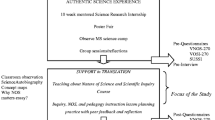Abstract
An emergent design qualitative study generated grounded theory explaining what happened when a professor taught five preservice elementary science methods classes modeling inquiry. Data sources included classroom observations, interviews, students’ reflective journals, and artifacts from other student assignments. Member checking was done with individuals and groups during each course and in exit interviews Findings suggested students’ expectations for learning and teaching science originated in the culture in which they lived. Features of their culture, grounded in the data, emerged. The values, assumptions, beliefs, personality profiles, and behaviors that dominated their culture did not support teaching and learning through inquiry. Discrepancies between students’ expectations and course reality led to frustration and anxiety expressed as resistance to inquiry learning and teaching. Students’ culture was compared to the culture of science using five analytical frameworks: (1) the ethics of science presented in the National Science Education Standards, (2) the nature of science as revealed in science teaching, (3) the biological evolution of “curiosity” as a basis for science, (4) social psychological theory relating to need for achievement and fear of failure, and (5) preferred style of social action. Triangulating these analyses, we concluded that the culture of traditional preservice elementary methods students was the antithesis of the culture of science. This cultural class has implications for strategies to enhance preservice elementary teacher education to meet the National Science Education Standards’ focus on inquiry.
Similar content being viewed by others
References
Aikenhead, G. S. (1996). Science education: Border crossing into the subculture of science.Studies in Science Education, 27, 1–52.
American Association for the Advancement of Science: Project 2061. (1993).Benchmarks for science literacy. New York: Oxford University Press.
Barnes, M. B., & Spector, B. S. (1999, January).Creating contexts for inquiry in science teacher preparation: How do we do it? Paper presented at AETS Annual Conference, Austin, TX.
Blosser, P. E. (1984).Attitude research in science education. Columbus, OH: ERIC Clearinghouse for Science, Mathematics, and Environmental Education.
Biological Sciences Curriculum Study (BSCS). (1998).Decisions in teaching elementary school science. Bloomington, IN: Agency for Instructional Technology.
Cobern, W. W., & Aikenhead, G. S. (1998). Cultural aspects of learning science. In B. J., Fraser & K. G. Tobin (Eds.),International handbook of science education (pp. 39–52). Boston: Kluwer Academic Publishers.
Erickson, F. (1998). Qualitative research methods of science education. In B. J. Fraser & K. G. Tobin (Eds.),International handbook of science education. Boston: Kluwer Academic Publishers.
Florida Department of Education. (1996).Science: PreK-12 sunshine state standards and instructional practices. Tallahassee: Author.
Gall, M. D., Borg, W. R., & Gall, J. P. (1996).Educational research: An introduction. White Plains, NY: Longman.
Glaser, B. G., & Strauss, A. L. (1967).The discovery of grounded theory. Chicago: Aldine
Glickman, S. E., & Schiff, A. D. (1967). A biological theory of reinforcement.Psychological Review, 74, 81–109.
Greenwald, A. G., & Banaji, M. R. (1995). Implicit social cognition, attitudes, self-esteem, and stereotypes.Journal of Personality and Social Psychology, 102, 4–27
Jacobs, E. (1987). Qualitative research traditions: A review.Review of Educational Research, 57 (1), 1–50.
Koch, J. (1990). The science autobiography project.Science and Children, 28(3), 42–44.
Koch, J. (1993). Restructuring elementary science teacher education: An imperative.Initiative, 55(3), 66–71.
Koch, J. (1999).Science stories: Teachers and children as science learners. Boston: Houghton Mifflin Co.
Loucks-Horsley, S., and colleagues. (1990).Elementary school science for the 90’s. Alexandria, VA: Association for Supervision and Curriculum Development
Lowry, D. (1989).True colors. Riverside, CA: Communications International.
Mallow, J. V. (1986).Science anxiety: Fear of science and how to overcome it. Clearwater, FL: H&H Publishing Co.
McClelland, D. C. (1963).The achieving society. Princeton, NJ: Van Nostrand.
McClelland, D. C. (1965). Achievement and entrepreneurship: A longitudinal study.Journal of Personality and Social Psychology, 1, 389–392.
McClelland, D. C. (1985).Human motivation. Glenview, IL: Scott Foresman.
McComas, W. F. (Ed.). (1998).The nature of science in science education. Boston: Kluwer Academic Publishers.
Murray, H. A. (1938).Explorations in personality. New York: Oxford University Press.
National Research Council (NRC). (1996).National science education standards. Washington, DC: National Academy Press.
Novak, J. D, (1998).Learning, creating, and using knowledge: Concept maps as facilitative tools in schools and corporations. Mahwah, NJ: Lawrence Erlbaum Associates.
Orlich, D. C. (1980).Science anxiety and the classroom teacher. Washington, DC: National Education Association.
Seligman, M. E. P. (1970). On the generality of the laws of learning.Psychological Review, 77, 406–418.
Seligman, M. E. P. (1971). Phobias and preparedness.Behavior Therapy, 2, 307–320.
Spector, B. S., Strong, P., & La Porta, T. (1998). Teaching the nature of science as an element of science, technology, and society. In W. F. McComas (Ed.),The nature of science education (pp. 267–276). Boston: Kluwer Academic Publishers.
Strauss, A., & Corbin, J. (1990).Basics of qualitative research: Grounded theory procedures and techniques. Newbury Park, CA: Sage.
Whetten, D. A. (1989). What constitutes a theoretical contribution?Academy of Management Review, 14, 490–495.
Wilson, E. O. (1998).Consilience. New York: Alfred A. Knopf.
Yelvington, K.A. (1999). Personal communication.
Author information
Authors and Affiliations
Corresponding author
Rights and permissions
About this article
Cite this article
Spector, B.S., Strong, P.N. The culture of traditional preservice elementary science methods students compared to the culture of science: A dilemma for teacher educators. J Elem Sci Edu 13, 1–20 (2001). https://doi.org/10.1007/BF03176929
Accepted:
Issue Date:
DOI: https://doi.org/10.1007/BF03176929




